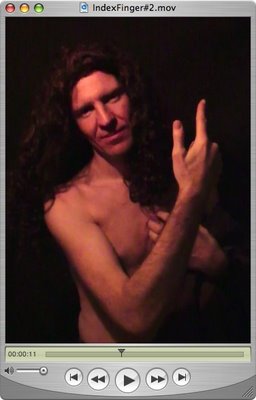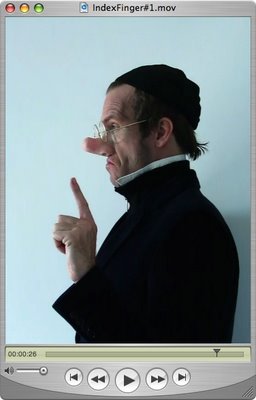Saturday, October 13, 2007
Tuesday, October 02, 2007
Cell Portraits

Watch the Video
"Cell Portraits" gives an impression of the daily work of a cell biologist and offers a view behind usually closed laboratory doors.
In search for molecules regulating the cell, biologists use visual tools such as microscopy to study where those molecules are and what they do.
The short movie (4'18'') documents the procedure of creating a microscopic image of cells. - These "micrographs" bear scientific information; but they also entail aesthetic qualities that attract public attention.
A project by Jan Schmoranzer and Richard Jochum. Columbia University, New York 2005-2007
Wednesday, September 12, 2007
Cellportraits (old version)

Watch the Video
This video was revised and updated on Oct 2, 2007. - More information: http://cellportraits.blogspot.com
Wednesday, August 29, 2007
To And From
This is the documentary video (8'40'') of an installation project at the Kinetic Arts and Sciences Center, New York, done by Richard Jochum with many thanks to Elaine Summers, Gudrun Diermayr, Ken Allen, Marlene Nichols, Jan Schmoranzer, Jeep Rosenberg, Anna Aloisia Moser, Brian Hennessey, Peisung Tsai, Heike Rebholz, Sebastien Sanz de Santamaria, Jean Barbaris, Marion Boultbee, Bill Costanzo, Meg Chang, Sam Kedem et al.
The presented works on view are mixed media installations in order to create kinetic spaces. Doing so To and From refers to the creative work of Elaine Summers and her Kinetic Arts and Sciences Center who is dedicated to choreography, dance performances, visual and intermedia art. In greater detail the following pieces will be on display:
Five jumping balls from a toy shop with grips to hold on and for visitors usage while being video taped. Four of them are in a bright yellow, one is in a luminous green. All will show dark green silk screen imprints with the lettering esc and are filled with helium - too heavy to fly but surprisingly light when it comes to jumping. The so called "escape objects" are inspired by working with the computer keyboard and the esc-key in particular - a key that promises immediate exit from the active application. Concerning the bouncing balls this promise comes with a wink: There is no such thing as escape and every attempt to do so is doomed to fail. Or have you ever seen exhibition visitors escaping on bouncing balls through the streets of the city of New York? Sizes: 23 resp. 19 inches.
"The threshold as a swing"is a reconstructed wooden threshold hanging from the ceiling two inches above ground and that way turning into a swing. It symbolizes the space that lies in between two rooms, i.e. the room in between. Who steps on it, will be at the cusp of it trembling and fluctuating. The threshold does not decide between the one and the other area, it stands on both.
And yet being a swing the threshold never stays steady; it is torn, toggling back and forth, swaying "to and from"; till the momentum comes to a crises: identifying the crisis and as such exemplifying a situation that has to be overstepped: by carrying the bride into the next stage of commitment for instance.
The piece recalls a figure from medieval times: the hagazusa (haga = thing; zusa = fence), i.e. the person sitting on the top of a fence and therefore marking the fine (yet fictitious) line between wood and village, between wilderness and civilization, jeopardizing the established rules and certainty of clear cut facts and solid knowledge. Personifying the perils of unknown territory the hagazusas were quickly defamed as witches or hags, indicted and burnt in the flames of inquisition. Size: 32 x 11 x 1 inches; hanging on two 13 feet ropes.
The image of the crisis finds its expression in a further piece: In a pair of dice hanging from the ceiling as if just tossed and frozen in the middle of a "cast". The result of the throw is not clear. Will it be a double six? Or just one and one? Variation of Caesar's saying: The die is cast. The die is NOT cast! Alea NON iacta est! Art is continuously challenged by finding new expressions of our time being. Size: 16 x 16 x 16 inches each.
"Plaster Room. All Waltz!" is the title of the production of an accident that happened to take place at the Kuenstlerhaus Passage Gallery in Vienna in 1998. A video documentary taped and cut by the Austrian media artist Wolfgang Neipl and photographs show how visitors get plastered by medical staff on freely selected parts of their body. Subsequently people dance to a modern version of electronic Waltz music.
"Installation with music for two dancers" is a new piece showing a pair of cd-players with earplugs hanging from a wall and ready to get picked by those visitors who want to dance to the music that is supposed to play different tracks. As the rest of the audience won't hear any music at all, the dancing turns into a performance of movements within space, a riddle about the dancers interaction and potential synchronicity.
To and From took place from Oct 19 - 26, 2005
Monday, July 16, 2007
Falling
Friday, July 06, 2007
Halt 2007

Watch video
Artist Richard Jochum saws himself off the branch he sits on and falls. Sound: sawing noises, and branch cracking. New York 2007. Continuation of a performance series which started in Vienna 2001.
Tuesday, June 26, 2007
Thursday, May 31, 2007
Monday, May 21, 2007
Row! Row! Sispyhus!

Watch this movie
BTW Rowing without moving is an experience that happened to me in 1987: I drifted off shore on the Lake of Kinneret, Israel, rowing for 3 hours without noticing any result. The Lake is known - to those who know - to be fed by underground springs which - together with the wind - create a movement from North to South. I had no clue, neither the friend who shared my despair.
Saturday, May 19, 2007
Sisyphus in Winter Wonderland

Watch Movie [1'29'']
Rolling a snow ball until it gets too heavy to be moved by a single person. A video performance by Richard Jochum, New York 2007. Part of a series dealing with futility, complexity, ritualized trying, and Sisyphus. "One must imagine Sisphyus happy" (A. Camus) Even more so in winter wonderland where the rolling stones are out of snow.
Monday, February 26, 2007
Index Finger #3 (archive-link)

Watch this clip
IndexFinger #3 is part of a photographic video portrait series on the decisive role of a gesture, namely the index finger, throughout the history of religion, philosophy, and pop-culture. #3 is a psycho-dramatic imitation of Raphael's famous fresco "The School of Athens" depicting the major philosophers of ancient Greece. One of its central figures, Plato, serves as a template for the 3rd video portrait, showing him while holding his right arm up and pointing with his index finger towards -- most likely -- the sun as a sympol for the scholastic trinity of the good, the whole, and the truth. Raphael's fresco from 1510-11, housed in the Museum of the Vatican, is frequently a focal point of an inflamed debate among art historians over its historical value, yet it was understood to be one of the central paintings introducing neoplatonism in Italy. The video portraits were created by Richard Jochum and greatly supported by Aphrodite Desiree Navab. Altogether they constitute a tryptich installation which will be part of the group exhibition, "What's Good Must Not Necessarily Be Evil", at Kunstraum Vaduz, Liechtenstein in April/May 2007.
Index Finger #2 (archive-link)

Watch this clip
IndexFinger #2 is part of a photographic video portrait series on the decisive role of a gesture, namely the index finger, throughout the history of religion, philosophy, and pop-culture. #2 is a psycho-dramatic imitation of Leonarda Da Vinci's famous oil painting, Saint John the Baptist, painted between 1513-1516, housed in the Louvre, Paris. Da Vinci's paintings often depict esoteric, androgynous characters with a slight touch of an almost diabolic darkness. John the Baptist shows the saint pointing towards somebody else, the gesture of a disciple towards his master. The video portraits were created by Richard Jochum and greatly supported by Aphrodite Desiree Navab. Altogether they constitute a tryptich installation which will be part of the group exhibition, "What's Good Must Not Necessarily Be Evil", at Kunstraum Vaduz, Liechtenstein in April/May 2007.
Index Finger #1 (archive-link)

Watch this clip
IndexFinger #1 is part of a photographic video portrait series on the decisive role of a gesture, namely the index finger, throughout the history of religion, philosophy, and pop-culture. #1 is a psycho-dramatic imitation of Wilhelm Busch's famous 19th century graphic novel, Max and Moritz (http://www.fln.vcu.edu/mm/mmeng4.html) which still plays an essential role in German-speaking popular culture. The depicted part is based on the illustration of the fourth trick. This segment focuses on Lehrer Laempel, the heamadster of the local school who is a feared moral authority. As the story unfolds he gets blown up by the two main characters who are child pranksters, Max and Moritz. The novel itself is a cautionary tale about the destructiveness and the drama resulting from going over the edge of naughtiness. The video portraits were created by Richard Jochum and greatly supported by Aphrodite Désirée Navab. Altogether they constitute a tryptich installation which will be part of the group exhibition, "What's Good Must Not Necessarily Be Evil", at Kunstraum Vaduz, Liechtenstein in April/May 2007.
Wednesday, February 21, 2007
IndexFinger#3
IndexFinger#2
IndexFinger#1
Monday, February 19, 2007
KAS - Ken Allen Studios
Sunday, February 04, 2007
Sisyphus On Vacation
The project aims for the almost impossible rather than to maximize the possible; given that art cannot move mountains and land art, in particular, seems almost absurd in a context where the landscape itself is shaped with utmost beauty and splendor. Thus the project intertwines a tragic moment with a comical one. To haul 61 stones uphill will not stop the erosion of the Alps. To try it, nonetheless, turns the attempt at best into a good joke.
To participate in a cumbersome hauling while sweating profoundly equals a ritual purification of sorts in a world that has gone crazy and will not concede to peace at all. It imitates the old Greek figure of a blinded Sisyphus in his futile attempt to roll a boulder uphill that would only roll back down just before reaching the summit--again and again. The Alps will ultimately do the same, and instead of Zeus it will be Gravity who is enforcing the job. Subsequently, it seems slightly bizarre to paint grayish stones gray, scale them, and add numbers to them as if surveying land. As it is delicate to persuade co-hikers to participate in carrying stones manually when anything alike nowadays is done by machines.
"You are doing quite the opposite of what everybody does", was the reaction of a giggling hiker who walked down from the summit. "Everybody schleps stones down, and you are hauling them up."
We give what we have. Our doubts are our passion. Our passion is our purpose. Everything else is the lunacy of art. (Philip Roth)
"Sisyphus on Vacation becomes a communal ritual of giving back to the mountain, but what the mountain never asked for in the first place. The small mound of painted stones stands awkwardly against the towering mountain range as marker of too little and too late. There is something though in the gesture of the self-inflicted trial by the artist and his voluntary collaborators that attests to the power of communal effort and healing. One silent, solitary stone joins another and another until their voices are too loud to ignore. (Aphrodite Désirée Navab)










